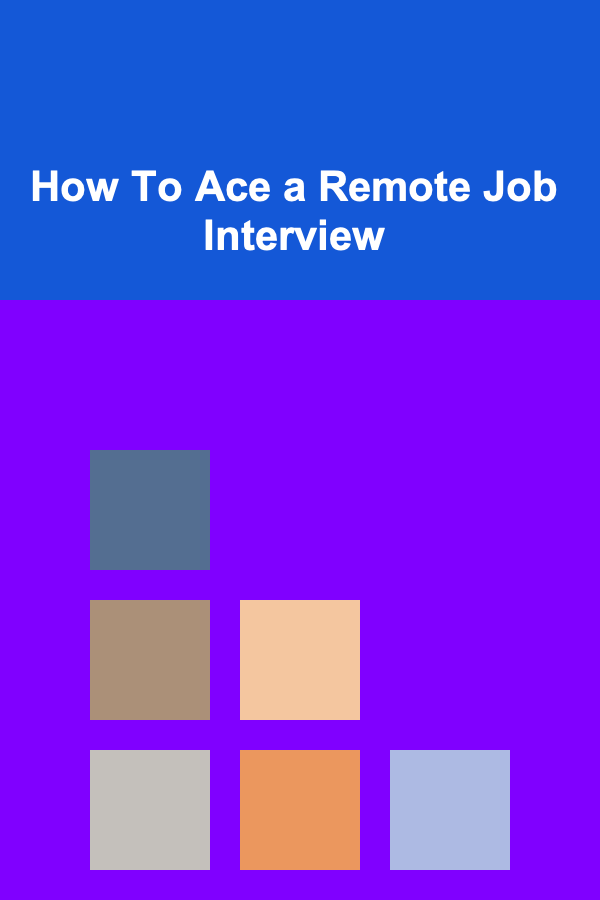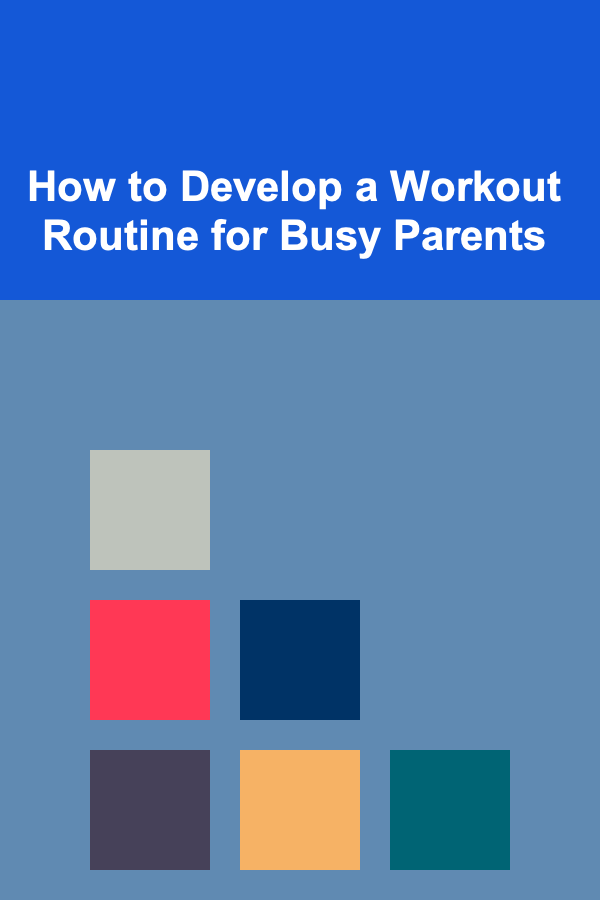
How To Ace a Remote Job Interview
ebook include PDF & Audio bundle (Micro Guide)
$12.99$10.99
Limited Time Offer! Order within the next:

In recent years, remote work has become increasingly popular, and with it, remote job interviews have also gained momentum. Whether you're applying for a full-time remote position or a hybrid role, succeeding in a remote job interview requires a distinct set of skills compared to traditional in-person interviews. In this article, we'll explore how to prepare for and excel in a remote job interview, focusing on the key factors that will help you stand out in a virtual environment.
Understanding Remote Interviews
Before diving into tips and strategies for acing a remote job interview, it's important to understand the nature of these interviews. A remote job interview typically involves video calls, and sometimes even phone interviews, rather than face-to-face interactions. They are often conducted through platforms such as Zoom, Skype, Google Meet, or Teams. The interviewer may be in a different city, state, or even country, making preparation and execution critical.
The remote nature of these interviews means that the usual factors you'd consider in an in-person interview --- such as body language, eye contact, and presentation --- need to be adapted to a digital format. In this article, we will break down several aspects of a remote job interview, from preparation to execution.
Prepare Your Technology
1.1. Test Your Equipment
Technical issues can disrupt the flow of an interview and leave a poor impression. It's essential to test all your equipment ahead of time. Make sure your computer, internet connection, microphone, webcam, and any other relevant technology are functioning properly. Here's a checklist:
- Camera: Test the positioning and lighting of your camera. It should be at eye level, so you don't have to tilt your head up or down. Make sure the lighting is good, with natural light being the best option. Avoid sitting with a bright light source behind you, as it can create a shadowy, unflattering look.
- Audio: Ensure your microphone is working and that there is no static or echo. Test the sound quality by recording a video message or making a test call with a friend.
- Internet: A stable and fast internet connection is crucial for a smooth video interview. If possible, use a wired Ethernet connection instead of relying on Wi-Fi to avoid interruptions. Test your connection to make sure the video doesn't freeze or buffer frequently.
- Platform Familiarity: Familiarize yourself with the video conferencing software used for the interview. Download the necessary apps and create a test meeting to ensure you're comfortable with the platform's features, such as muting/unmuting your microphone, turning your camera on/off, and sharing your screen if required.
1.2. Have a Backup Plan
Even with the best preparation, technical issues can still arise. Have a backup plan in place in case something goes wrong. For example:
- Have a phone nearby in case the video connection fails. You can offer to switch to a phone call with the interviewer.
- If you're using Wi-Fi, have a mobile hotspot ready as a backup internet source.
Create an Ideal Interview Environment
2.1. Choose a Quiet, Well-lit Space
Find a quiet space where you can conduct the interview without distractions. Inform others in your household or workspace that you'll be in an interview to minimize interruptions. If possible, pick a space with a door you can close to further limit disturbances.
The background matters too. Choose a neutral, tidy space to avoid distractions. A plain wall or bookshelf works well. Avoid busy or cluttered backgrounds that can divert the interviewer's attention away from you.
Ensure there is sufficient lighting in the room. Natural light is ideal, but if that's not available, use a soft light source positioned in front of you, not behind. This prevents a shadowy or overly dark appearance.
2.2. Consider Your Professional Attire
Although remote interviews may offer more flexibility in terms of attire, it's important to dress professionally. Your clothing should match the company culture but still project professionalism. Even if you're wearing casual clothes, avoid anything too informal, like a hoodie or T-shirt with graphic designs.
Choose solid, neutral colors rather than busy patterns, which can be distracting on camera. Your attire should reflect the level of formality of the company you're interviewing with, but it's always better to be slightly overdressed than underdressed.
Master Your Presentation
3.1. Maintain Eye Contact
Eye contact is crucial in any interview, and it can be more challenging to maintain during remote interviews. To mimic eye contact on a video call, look directly into the camera rather than at the screen. This creates the illusion of eye contact, which helps establish a connection with the interviewer.
That said, it's natural to glance at the screen occasionally to check the interviewer's body language or facial expressions. Just be mindful to return to looking at the camera to maintain the sense of engagement.
3.2. Posture and Body Language
Even though you're not in the same room as the interviewer, your body language still matters. Sit up straight, avoid slouching, and ensure your shoulders are relaxed. This communicates confidence and professionalism.
Avoid excessive hand movements or fidgeting, as it can be distracting on camera. Instead, keep your hands resting on the table or your lap when you're not speaking. If you need to gesture, do so sparingly and naturally.
3.3. Avoid Multitasking
Remote interviews often take place in environments where it's easy to get distracted. However, it's essential to stay focused. Avoid checking your phone, responding to emails, or opening other windows on your computer while the interview is in progress. This not only appears unprofessional, but it can also cause you to miss key questions or comments from the interviewer.
Showcase Your Communication Skills
4.1. Speak Clearly and Concisely
Clear communication is key in a remote interview. Make sure you speak slowly and clearly, especially if you have an accent or if the interviewer has a hard time hearing you. Be mindful of how long your responses are---answer the question thoroughly but avoid rambling.
When you're listening, use non-verbal cues, like nodding, to show the interviewer you're engaged. If there's a delay in the conversation, be patient and allow the interviewer to finish speaking before you respond. Interrupting can be more noticeable in remote interviews.
4.2. Be Ready to Discuss Remote Work Skills
Since you're interviewing for a remote position, be prepared to discuss your experience with remote work or your ability to work independently. Employers are looking for candidates who are self-motivated, disciplined, and comfortable with virtual collaboration tools.
Be ready to highlight your ability to manage your time, stay organized, and communicate effectively in a remote environment. If you've worked remotely in the past, share examples of how you managed your workload, stayed productive, and communicated with your team.
4.3. Handle Delays and Technical Issues Gracefully
In remote interviews, delays or technical issues can happen. If there's a lag in the conversation or if the video or audio cuts out, stay calm and patient. Politely ask for clarification or request that the interviewer repeat their question if necessary. Always remember that technical issues are a part of the remote experience, and handling them gracefully will demonstrate your adaptability.
Prepare for Common Remote Interview Questions
While remote job interviews may vary in format, many interview questions will be similar to those asked in in-person interviews. Here are some common questions to expect:
- Tell me about yourself. This is a common icebreaker question. Use it to briefly introduce your background, your skills, and what attracted you to the position.
- Why do you want to work remotely? Discuss your motivations for seeking a remote role, whether it's a better work-life balance, the flexibility to work from different locations, or your ability to stay productive in a home office.
- How do you stay organized and manage your time? Share your approach to task management, scheduling, and prioritization. Mention any productivity tools you use, such as Trello, Asana, or Google Calendar.
- How do you handle communication in a remote setting? Talk about your experience with virtual collaboration tools, such as Slack, Zoom, or Teams, and how you ensure that you stay connected with colleagues.
- How do you maintain motivation and avoid distractions while working remotely? Provide examples of how you create a productive work environment at home, set goals, and stay focused.
Follow Up After the Interview
Just like in an in-person interview, sending a follow-up email is a good practice. Thank the interviewer for their time, reiterate your interest in the position, and highlight any key points you may not have had a chance to discuss during the interview.
In your follow-up, you can also reference something specific from the conversation that stood out to you, which shows that you were attentive and engaged during the interview.
Conclusion
Acing a remote job interview requires a combination of technical preparation, effective communication, and adaptability. By testing your equipment, setting up a professional interview environment, and preparing for questions, you can put yourself in the best possible position to succeed. With the right mindset and approach, remote interviews can be a great opportunity to demonstrate your skills, professionalism, and fit for the role.
By following these tips and making a positive impression, you can increase your chances of landing your dream remote job. Remember that remote work requires a unique set of skills, so showing your preparedness for the remote work environment is crucial to standing out as a candidate.

How to Make Your Party Food Look as Good as It Tastes
Read More
How to Sell Handmade Leather Goods on Instagram: An Actionable Guide
Read More
How to Develop a Workout Routine for Busy Parents
Read More
Understanding Decentralized Applications (DApps): A Deep Dive
Read More
How to Polish Faceted Gemstones: A Step-by-Step Process
Read More
How to Photograph Architectural Details
Read MoreOther Products

How to Make Your Party Food Look as Good as It Tastes
Read More
How to Sell Handmade Leather Goods on Instagram: An Actionable Guide
Read More
How to Develop a Workout Routine for Busy Parents
Read More
Understanding Decentralized Applications (DApps): A Deep Dive
Read More
How to Polish Faceted Gemstones: A Step-by-Step Process
Read More